From awe-inspiring geological features to diverse ecosystems, Utah’s sanctuaries of nature paint a one-of-a-kind canvas that every outdoor enthusiast craves to explore. With no less than 15 impeccable National and State Parks, Utah establishes itself as an unrivaled hub for invigorating adventures and inspiring vistas. In this piece, we take you on a journey through mountains, canyons, deserts, rivers, and the wilderness, savoring the ethereal beauty and unspoiled charm these parks have to offer. Whether you’re an avid hiker, a passionate wildlife photographer, or merely a nature romantic yearning for harmony, our guide to the 15 best National and State Parks in Utah promises an unforgettable voyage. Ready to get lost in Mother Nature’s masterpiece?
1. Arches National Park
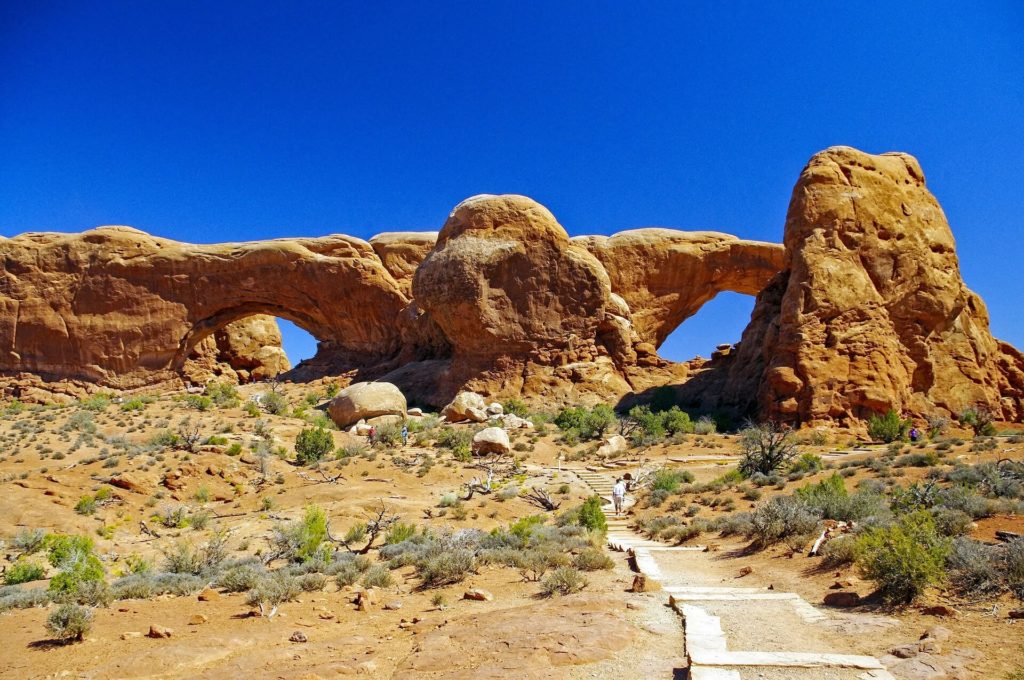
Arches National Park, located in eastern Utah, USA, is a stunning natural preserve known for its captivating geological features, including over 2,000 natural sandstone arches. This park, which spans over 76,679 acres, offers a fascinating glimpse into the Earth’s evolutionary history and is a popular destination for hikers, nature enthusiasts, and photographers.
The Formation of the Arches
Geological History: The formation of the arches dates back millions of years. The story begins with the deposition of salts and sediments from evaporated sea beds. Over time, these layers were buried by further deposits and compressed into rock. Geological uplift and erosion have sculpted these rock layers into the remarkable formations seen today.
Erosive Forces: The unique arches are primarily the result of erosive forces such as water and ice. The park’s arid climate and temperature fluctuations contribute to the erosion process, causing the rock to expand and contract, which eventually leads to cracks and natural arch formations.
Notable Features and Arches
- Delicate Arch: Perhaps the most iconic feature of the park, Delicate Arch stands alone, framing the La Sal Mountains and has become a symbol of Utah.
- Landscape Arch: With a span of over 290 feet, Landscape Arch is one of the longest natural arches in the world.
- Double Arch: A remarkable formation consisting of two giant arches that share a common end.
- Fiery Furnace: This is a labyrinth of sandstone canyons and fins that requires a permit or a ranger-led tour to explore.
Flora and Fauna
Despite its desert environment, Arches National Park supports a variety of plant and animal life.
Vegetation: The park is home to drought-resistant plants such as yucca, cacti, and various shrubs adapted to the harsh conditions.
Wildlife: Visitors might encounter animals like the desert bighorn sheep, antelope squirrels, and a variety of bird species, including the peregrine falcon and the white-throated swift.
Recreational Activities
- Hiking: There are numerous trails ranging from easy walks to challenging hikes. Popular hikes include the Delicate Arch Trail, Devils Garden Trail, and the Windows Trail.
- Photography: The park’s unique landscape offers endless opportunities for photography, especially during sunrise and sunset when the rocks glow red.
- Stargazing: With minimal light pollution, Arches National Park is an excellent spot for stargazing and is recognized as a ‘Dark Sky Park’.
Visitor Information
- Best Time to Visit: The best times to visit Arches National Park are during the spring and fall, when temperatures are milder.
- Facilities: The park offers a visitor center with educational exhibits, a campground, and picnic areas.
- Regulations: To preserve the park, visitors are encouraged to follow Leave No Trace principles and to stay on designated trails at all times.
Conservation Efforts
The delicate ecosystem and geological features of Arches National Park are protected by the National Park Service. Conservation efforts focus on habitat restoration, invasive species management, and educating the public about the importance of preserving natural wonders.
2. Canyonlands National Park
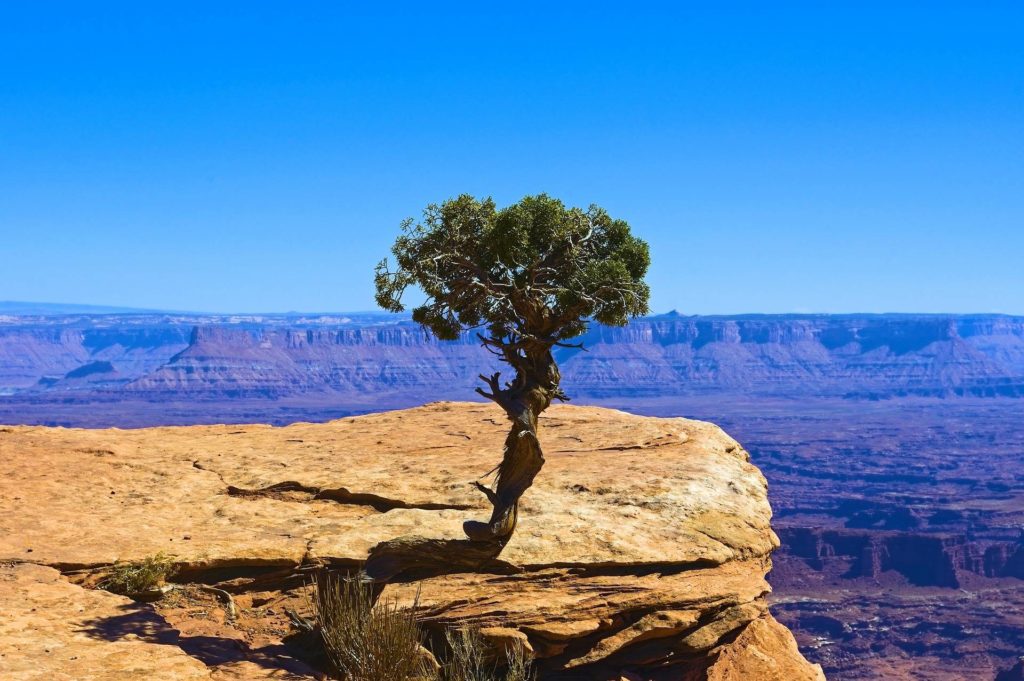
Located in southeastern Utah, Canyonlands National Park offers a diverse landscape of deep canyons, towering mesas, pinnacles, and arches carved by the Colorado River and its tributaries. Spanning over 337,598 acres, this park is divided into four distinct districts: Island in the Sky, The Needles, The Maze, and the rivers themselves, each offering unique experiences and breathtaking vistas.
Geological Marvels of Canyonlands
Canyon Formation: Canyonlands National Park is a showcase of geology. Over millions of years, layers of sedimentary rock have been deposited by ancient seas, rivers, and windblown dunes, only to be later eroded by the relentless force of the Colorado River and the Green River.
Plateaus and Mesas: The Island in the Sky district is a broad and level mesa with panoramic overlooks towering over 1,000 feet above the surrounding terrain, offering some of the most accessible and dramatic viewpoints in the park.
The Four Districts of Canyonlands
- Island in the Sky: The most accessible district, with many overlooks and a few short hikes leading to spectacular views.
- The Needles: Named for its colorful spires of Cedar Mesa Sandstone, this area offers more challenging backcountry hikes and four-wheel-drive roads.
- The Maze: The most remote and least accessible district of the park, known for its solitude and complex canyon network.
- The Rivers: The Green and Colorado rivers divide the park into its districts and offer opportunities for rafting and kayaking.
Flora and Fauna
Despite the park’s harsh desert environment, Canyonlands supports a variety of life.
Vegetation: Plants like blackbrush, Mormon tea, and various cacti species have adapted to the low water availability.
Wildlife: The park is home to animals that are well adapted to the desert, such as the mule deer, coyote, and mountain lion. Birdwatchers may spot birds of prey, including the golden eagle and the peregrine falcon.
Recreational Activities
- Hiking: There are numerous trails across all districts, from easy walks to the more strenuous hikes like the Syncline Loop and the Joint Trail.
- Mountain Biking: The White Rim Road in Island in the Sky offers a challenging multi-day bike trip with incredible scenery.
- Four-Wheel Driving: The park features extensive four-wheel-drive roads that traverse the rugged backcountry.
- Whitewater Rafting: The rivers offer thrilling rafting adventures through some of the park’s most remote and scenic canyons.
Visitor Information
- Best Time to Visit: Spring and fall are the best seasons to visit, thanks to moderate temperatures and reduced crowds.
- Facilities: Each district has its own visitor center with information, exhibits, and bookstores. Backcountry permits are required for overnight trips.
- Regulations: Visitors are asked to respect the delicate desert environment, stick to trails and roads, and carry out all trash.
Conservation and Preservation
The National Park Service manages Canyonlands National Park with an emphasis on preserving its natural and cultural resources. Efforts include monitoring ecological changes, protecting historical sites, and promoting sustainable tourism practices.
3. Zion National Park
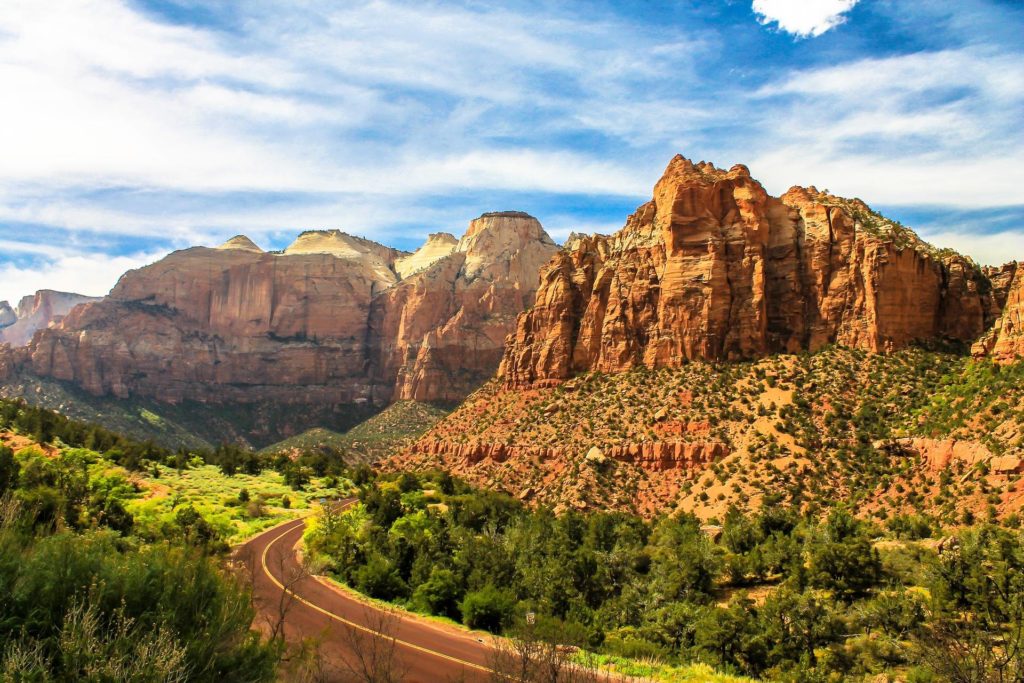
Nestled in the heart of southwestern Utah, Zion National Park is a sanctuary of towering cliffs, narrow canyons, and serene rivers. Established as a national park in 1919, it is the oldest and most visited park in Utah, renowned for its dramatic red rock landscapes and diverse ecosystems. The park covers 229 square miles and showcases the power of geological processes with its high plateaus, rock towers, mesas, and the winding Virgin River cutting through the sandstone.
Zion’s most iconic feature, Zion Canyon, is a marvel stretching 15 miles long and up to half a mile deep, with walls adorned by the reddish hues of Navajo Sandstone. This natural amphitheater is accessible via the Zion Canyon Scenic Drive or the park’s shuttle system during peak visitor seasons. Here, visitors can embark on a variety of trails ranging from easy riverside walks such as the Riverside Walk to the strenuous and vertiginous Angels Landing hike, which offers breathtaking panoramic views from its summit.
The park is much more than its famous canyon; it’s a haven for biodiversity. Over 1,000 plant species, 289 bird species, and 75 mammals call Zion their home, thriving in the diverse habitats ranging from desert to riparian and pine-covered highlands. For those looking to experience the solitude and wilderness of Zion, the Kolob Canyons in the northwest corner of the park provide a quieter retreat from the more frequented areas. Whether you’re a hiker, a photographer, or simply a nature lover, Zion National Park offers an unforgettable experience where the beauty of the American Southwest is on full display.
4. Bryce Canyon National Park
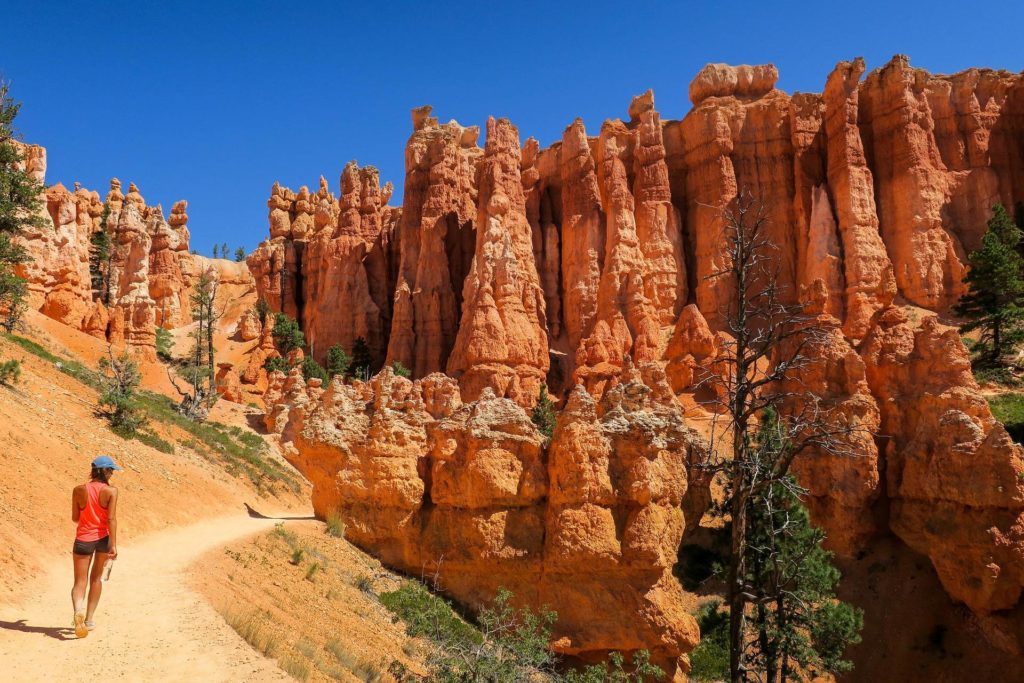
Nestled in the high plateaus of Southern Utah, Bryce Canyon National Park offers visitors a spectacular geological symphony that is unlike any other landscape in the world. Known for its unique geology, the park is home to the largest collection of hoodoos—tall, thin spires of rock that protrude from the bottom of arid basins. The park’s natural amphitheaters are carved into the edge of a high plateau, with the most famous being Bryce Amphitheater, which is filled with these whimsical rock formations. The park’s distinctive red, orange, and white rock layers reveal the chronology of the area’s geological history, leaving visitors in awe of what millions of years of erosion and uplift can create.
As you venture into the park, you’ll find that each viewpoint and trail offers a new perspective on the ever-changing landscape. Hikes like the Navajo Loop and Queen’s Garden trails allow you to meander through the maze of hoodoos and experience the park up close. For those seeking a less strenuous visit, a drive along the park’s 18-mile main road provides access to multiple overlooks, each offering breathtaking vistas, especially at sunrise or sunset when the canyon’s colors ignite. In addition to its famed rock formations, Bryce Canyon is also a sanctuary for wildlife, including the Utah prairie dog, and is recognized as a “Dark Sky Park,” which makes it an ideal spot for stargazing. Whether you’re exploring the depths of the amphitheaters or admiring the view from the rim, Bryce Canyon National Park is a place where the beauty and scale of the natural world can truly be felt.
5. Dead Horse Point State Park
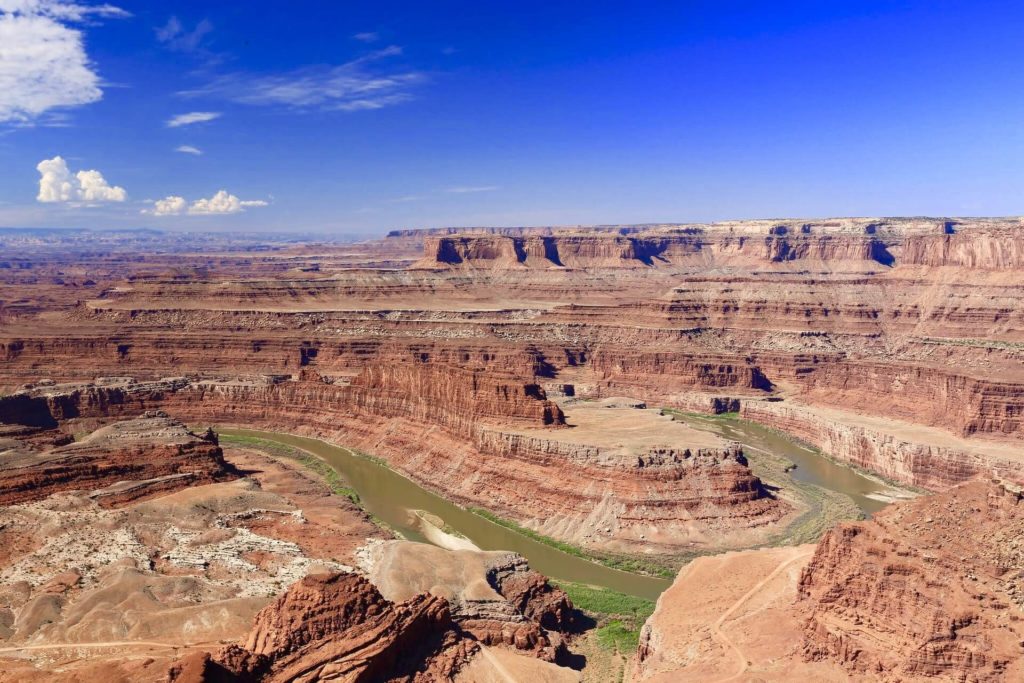
Nestled between Arches and Canyonlands National Parks, Dead Horse Point State Park offers its own unique and breathtaking spectacle of nature’s grandeur. The park is most renowned for the dramatic Dead Horse Point Overlook, where a narrow neck of land connects the mesa to the rest of the plateau, and it is from here that visitors can gaze out over the deep canyon carved by the Colorado River. This stunning vista unfolds a panorama of rugged desert landscape, with a view that extends beyond 2,000 feet down to the river below and out across the vast canyon country. The park’s name is steeped in folklore, associated with cowboys of the 19th century who used the point as a natural corral for wild mustangs.
Apart from its iconic viewpoint, Dead Horse Point State Park is a hub for outdoor enthusiasts. With miles of hiking trails like the East Rim and West Rim trails, visitors can explore the high desert environment, encountering a variety of plant and animal life adapted to this arid region. Mountain bikers will revel in the Intrepid Trail System, offering routes for all skill levels with the backdrop of the same incredible scenery. Moreover, the park’s commitment to preserving the night sky means that on a clear evening, stargazers are treated to an unobstructed view of the Milky Way. With its combination of natural beauty, recreational opportunities, and conservation efforts, Dead Horse Point State Park serves as a testament to the enduring allure of the American Southwest’s red rock country.
6. Coral Pink Sand Dunes State Park
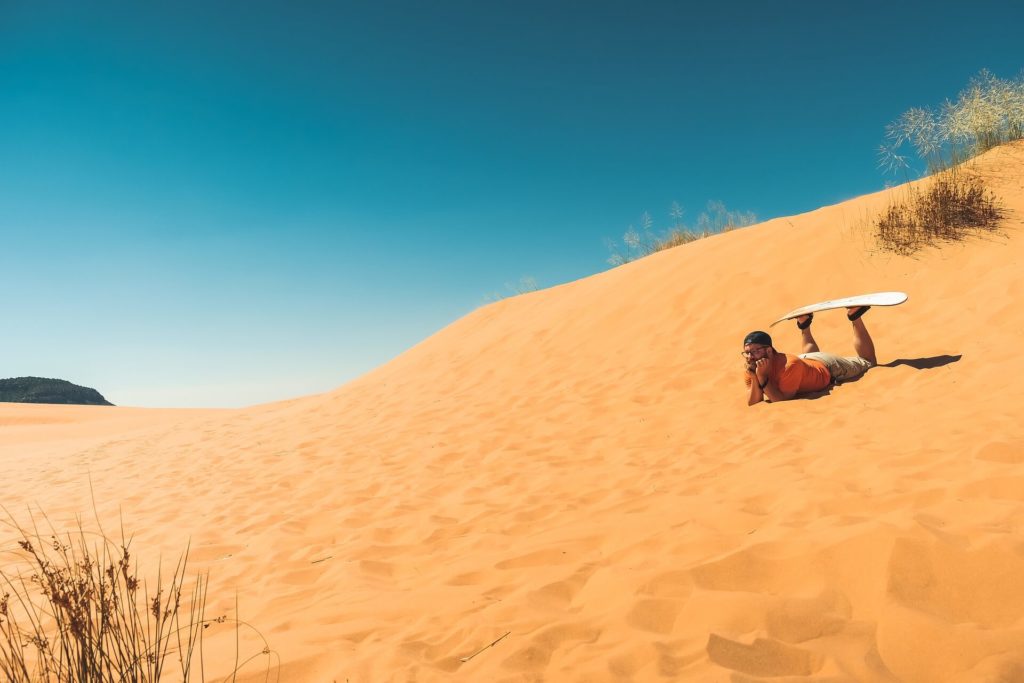
Nestled in southwestern Utah, between Mount Carmel Junction and the charming town of Kanab, lies the Coral Pink Sand Dunes State Park. This 3,730-acre park, set at an elevation of 6,000 feet, is renowned for its striking dune field with shades of coral and pink hues, which are particularly vibrant at sunrise and sunset. The dunes are a product of the eroding Navajo sandstone cliffs that surround the area, creating fine grains of sand that have accumulated over thousands of years.
Visitors of Coral Pink Sand Dunes can indulge in a variety of recreational activities. For adrenaline enthusiasts, the park offers 1,200 acres of open riding area for off-highway vehicles (OHVs), with two access points within the state park. All OHVs are required to be registered and must display an orange whiptail flag for safety. Riders are also expected to have a valid driver’s license or a state-recognized certification. For those preferring a slower pace, the park provides ample opportunities for hiking, wildlife watching, and photography, allowing guests to immerse themselves in the serene beauty of the dunes and the surrounding landscape.
Aside from the adventurous dune activities, Coral Pink Sand Dunes State Park is an excellent spot for camping. The park has two campground loops, both offering easy access to the sand dunes. Loop A is a more wooded area with closely spaced sites, while Loop B offers sites with water and electric hookups, spaced farther apart and with fewer trees. The campground is equipped with restrooms, hot showers, sewage disposal, picnic tables, and fire pits, ensuring a comfortable stay for all visitors. Due to the popularity of the park, it’s advisable to reserve a campsite in advance, as the campground tends to fill up quickly.
7. Sand Hollow State Park
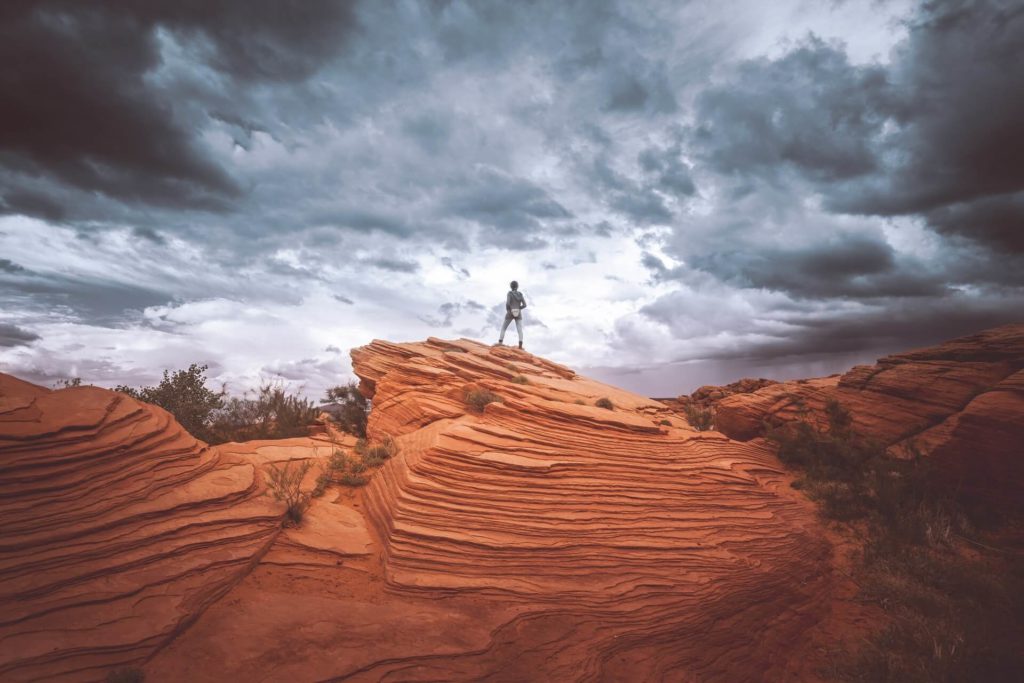
Nestled in the town of Hurricane, Utah, just a stone’s throw away from St. George, lies the breathtaking Sand Hollow State Park. This park is celebrated as one of Utah’s prime camping and recreational areas, boasting a harmonious blend of warm, blue waters and the distinct red sand beaches characteristic of the region. The park is particularly popular due to the Sand Hollow Reservoir, a welcoming oasis for water enthusiasts that offers a perfect setting for a variety of watersports such as boating, fishing, kayaking, and paddleboarding. Not to be outdone, the adjacent sand dunes beckon ATV riders and off-road adventurers to explore the sandy expanse of Sand Mountain, accessible directly from within the park.
Sand Hollow State Park is a hub of activity for both water and desert recreation. The park features multiple campgrounds including the Westside Campground, Sandpit Campground, Lakeview Campground, and Eastside Campground, each providing visitors with excellent amenities to ensure a comfortable stay amidst the natural beauty of Utah. For those seeking a rush, cliff jumping from the famous Jumping Rock is a thrilling experience, while the surrounding desert landscape offers miles of trails perfect for hiking, biking, and exploring. Whether you’re navigating the rolling dunes or diving into the clear waters, Sand Hollow provides a picturesque and exhilarating destination for adventurers and families alike.
8. Grand Staircase-Escalante National Monument
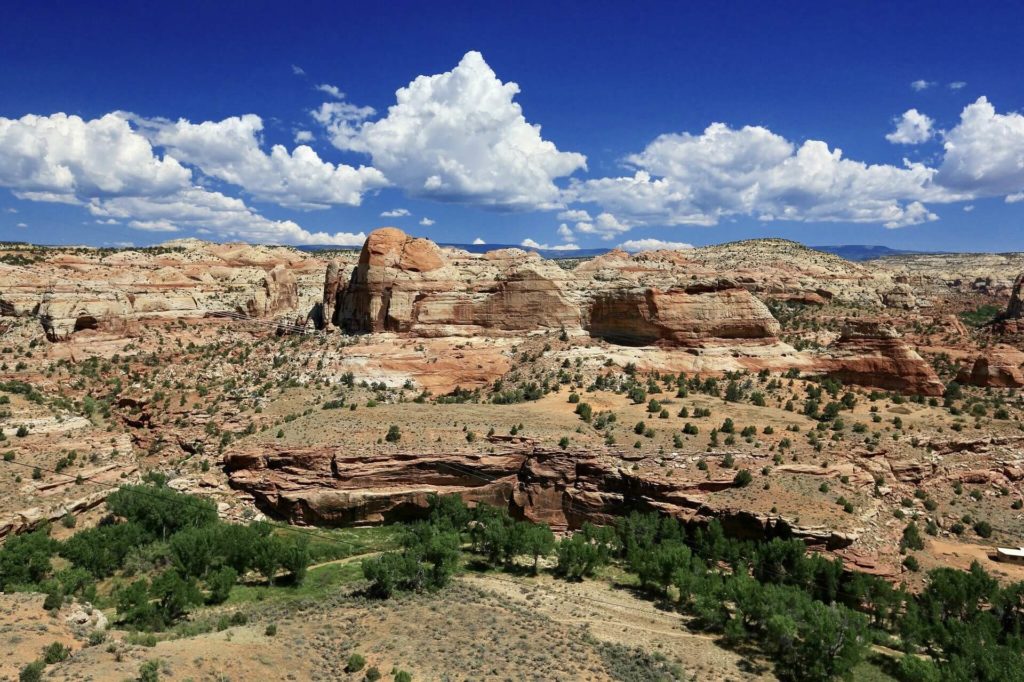
Grand Staircase-Escalante National Monument is a remarkable expanse of public land in southern Utah, celebrated for its unique geology, rich paleontological sites, and vast array of cultural and historical artifacts. Spanning nearly one million acres, this monument is a mosaic of canyons, arches, plateaus, and cliffs, with its terrain divided into three distinct regions: the Grand Staircase, Kaiparowits Plateau, and Escalante Canyon. Each area presents a different set of awe-inspiring geological formations and ecosystems, making it a treasure trove for scientists, hikers, and nature lovers.
The Grand Staircase region is characterized by a sequence of ascending cliffs and terraces that expose a chronological story of Earth’s history. The Kaiparowits Plateau boasts a rugged and remote landscape, housing a wealth of fossil records, while the canyons of the Escalante River feature a network of narrow slot canyons, waterfalls, and natural bridges carved by perennial waters. For visitors, the monument offers a range of activities from scenic drives, such as the All-American Road: Scenic Byway 12, to challenging backcountry hikes and river excursions. Despite the monument’s size, facilities are limited, and guests are encouraged to practice Leave No Trace principles to preserve the area’s pristine condition. Whether exploring the solitude of the backcountry or enjoying the more accessible sights, Grand Staircase-Escalante National Monument promises an unforgettable experience for those who venture into its vast and wild heart.
9. Cedar Breaks National Monument
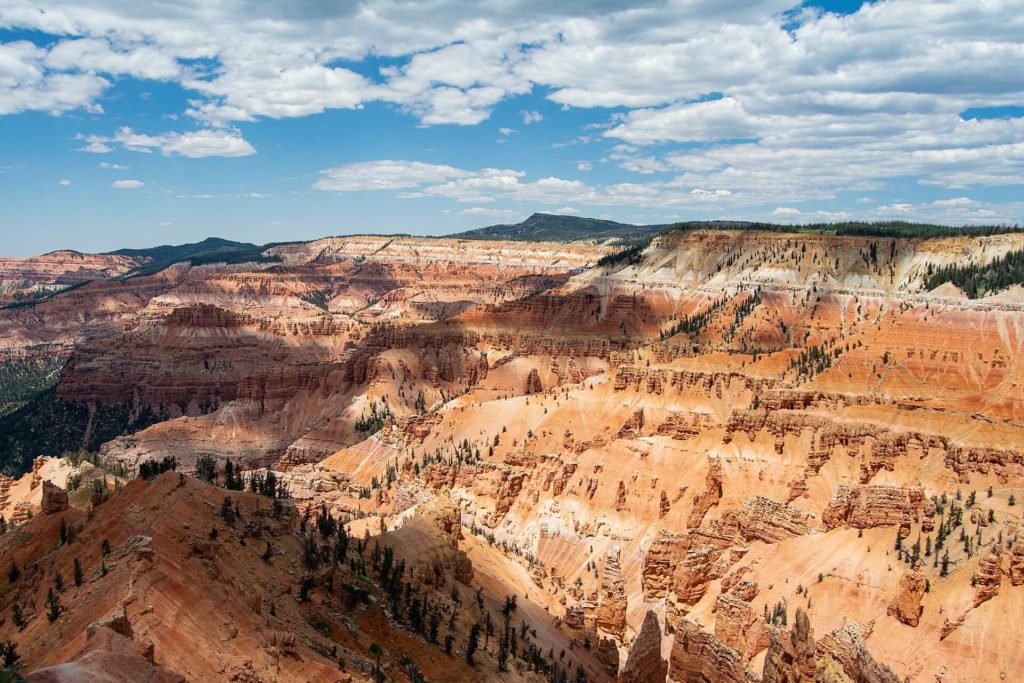
Cedar Breaks National Monument, crowning the grand staircase in Utah at over 10,000 feet, is a marvel of nature’s artistry. This natural amphitheater spans about three miles and plunges to a depth of over 2,000 feet, presenting a breathtaking display of spires, columns, and arches in a kaleidoscope of vibrant colors. The monument’s high elevation contributes to a unique subalpine ecosystem where visitors can wander through lush meadows of wildflowers and age-old bristlecone pines. As part of the Colorado Plateau, the geological formations here offer a window into the ancient past, with millions of years of uplift and erosion visible in the layers of rock.
Recreational activities at Cedar Breaks are plentiful throughout the year. In the warmer months, it’s an ideal spot for hiking, nature study, and photography, with trails like the Alpine Pond Trail and the Spectra Point Trail offering accessible routes to take in the views. The monument transforms into a premier destination for cross-country skiing and snowmobiling in the winter, thanks to the abundant snowfall it receives. The park’s visitor center, open from late May to mid-October, provides educational resources for those looking to learn more about the delicate desert environment. Despite the higher elevation leading to cooler summer temperatures and the potential for afternoon thunderstorms, the monument’s diverse landscape ensures a memorable visit regardless of the season.
10. Snow Canyon State Park
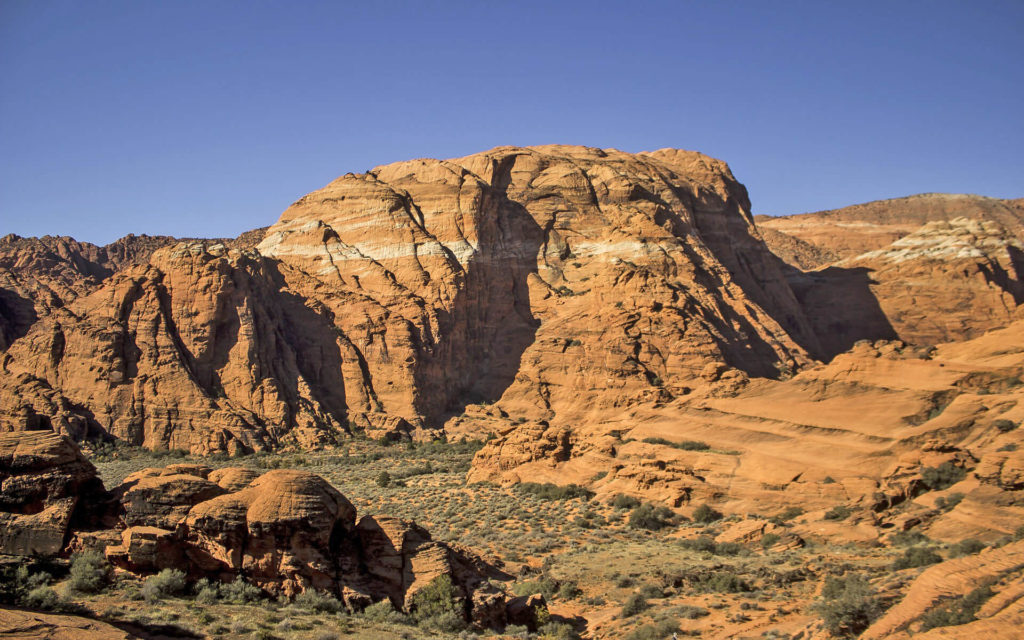
Nestled amidst lava flows and towering sandstone cliffs in a vibrant and fragile desert ecosystem, Snow Canyon State Park is a 7,400-acre scenic wonderland. The park, residing within the larger 62,000-acre Red Cliffs Desert Reserve, is designed to protect the delicate habitats of numerous species, including the federally listed desert tortoise. With over 38 miles of hiking trails, a three-mile paved walking and biking trail, and over 15 miles of equestrian trails, this state park is a haven for outdoor enthusiasts. The geological features of the park are a testament to the Earth’s natural forces, with wind-transported quartzite sand from 183 million years ago now forming the creamy white and burnt orange Navajo sandstone that dominates the landscape.
Visitors to Snow Canyon State Park can engage in a variety of activities, ranging from hiking and biking to horseback riding and camping. The park’s diverse ecosystem is home to an array of wildlife, including coyotes, kit foxes, and peregrine falcons, and offers a splendid display of wildflowers during favorable spring and fall conditions. Nature programs and junior ranger activities provide educational opportunities, and the park’s history, which dates back to 500 B.C., adds a rich cultural dimension to the experience. Artifacts indicate long-standing human interaction with the canyon, which has also served as the backdrop for Hollywood films.
Below is a table summarizing essential details about Snow Canyon State Park:
| Snow Canyon State Park | Details |
|---|---|
| Address | 1002 Snow Canyon Drive, Ivins, UT 84738 |
| Phone Number | 435-628-2255 |
| Park Elevation | 3,100 to 4,100 feet |
| Open Hours | Year-Round, 6 a.m. to 10 p.m. No holiday closures |
| Entrance Fees | $10-15 per vehicle (up to 8 people), $5 for seniors 65+ (with UT driver license), $5 for pedestrians/cyclists (up to 8 people) |
| Activities | Hiking, Biking, Camping, Picnicking, Horseback Riding, Photography |
| Camping | Available with tent sites and RV sites (up to 40 feet RVs), including electrical and water hookups, two group camping areas |
| Facilities | Developed campground, modern restrooms, showers, hiking/biking/equestrian trails, RV dump station |
| Reservations | Via ReserveAmerica online |
11. Capitol Reef National Park
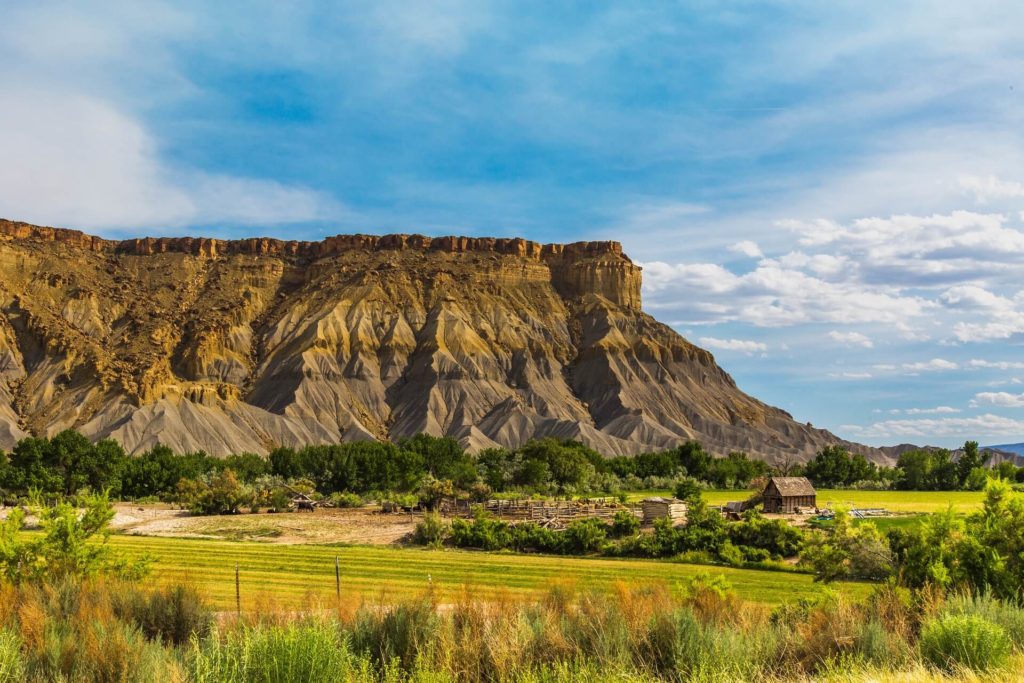
Capitol Reef National Park, located in the heart of Utah’s red rock country, is a hidden gem that showcases the unique geology of the Waterpocket Fold, a dramatic earth wrinkle extending nearly 100 miles. This geologic feature, a classic monocline formed by the Laramide Orogeny, presents a visual and scientific feast for visitors. The park’s landscape is a canvas of colorful cliffs, massive domes, soaring spires, stark monoliths, twisting canyons, and graceful arches, all shaped over millions of years by the forces of erosion. The area was named “Capitol Reef” because the whitish Navajo Sandstone cliffs with dome formations resemble capitol building domes, and “reef” refers to the rocky cliffs that pose a barrier to travel, much like a coral reef in the ocean.
The park is not only a wonder of geology but also rich in history, with petroglyphs left by the ancient Fremont Culture, and the historic pioneer settlement of Fruita, where orchards still bear fruit today. Visitors to Capitol Reef are invited to explore its diverse landscapes through a variety of activities, including hiking, backpacking, and scenic drives. The Scenic Drive provides an accessible route to some of the park’s highlights, but for those seeking a deeper connection with the rugged backcountry, there are hundreds of miles of trails and unpaved roads that lead into the heart of this extraordinary natural wonder.
| Feature | Details |
|---|---|
| Park Name | Capitol Reef National Park |
| Location | South-central Utah, USA |
| Notable Geologic Feature | Waterpocket Fold |
| Activities | Hiking, Backpacking, Scenic Drives, Fruit Picking (in season) |
| Camping | Developed and Primitive Campgrounds Available |
| Visitor Center | Information, Exhibits, Educational Programs |
| Pets | Allowed in Certain Areas, Restrictions Apply |
| Scenic Drive | Accessible Route to Park Highlights |
| Entry Fee | Required for Park Access |
| Contact Information | 435-425-3791, [email protected] |
12. Goosenecks State Park
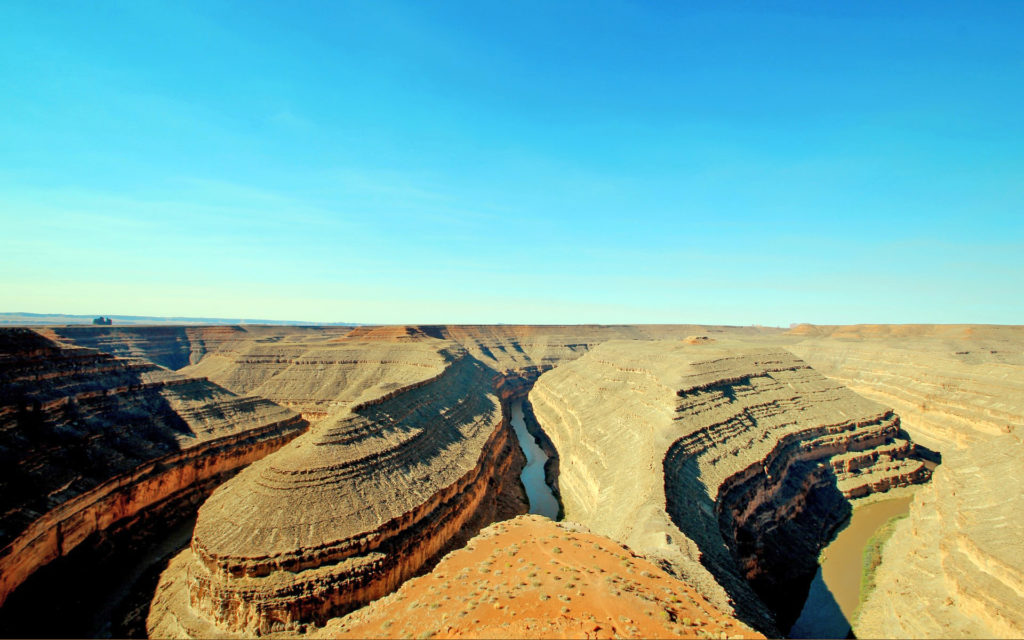
Goosenecks State Park offers a visual spectacle unlike any other in North America. As visitors stand on the edge of a deep canyon, they witness the San Juan River as it meanders through the desert below, creating a series of tight loops known as goosenecks. This geological phenomenon is the result of 300 million years of Earth’s natural processes, such as erosion by water, wind, frost, and gravity. The entrenched river meanders seen from the park are one of the most striking examples of their kind, formed as the Colorado Plateau uplifted, causing the river to carve deeply into the landscape.
While the park may be small, the views are vast and encompass a panorama that includes the volcanic Alhambra Rock in the distance, with the iconic buttes and spires of Monument Valley visible to the southwest. Visitors to the park can engage in various activities, including sightseeing, photography, and stargazing, thanks to the park’s expansive night sky. There’s also the opportunity for pet-friendly picnicking and camping in designated areas. It’s important to note that there are no designated hiking or bike trails within the park itself, and the climate can be intensely hot in the summer months, with little shade available.
| Feature | Details |
|---|---|
| Main Attractions | Entrenched river meanders (goosenecks) of the San Juan River |
| Location | SE Utah along US 163, about 25 miles west of Bluff |
| Contact Information | Goosenecks State Park c/o Edge of the Cedars State Park Museum, Blanding, UT 84511, (435) 678-2238 |
| Seasons/Open Hours | Open year-round, no closures |
| Entrance Fees | $5 per car, $2 per person for buses or groups, $10 per night for camping |
| Activities | Sightseeing, Photography, Stargazing, Picnicking, Primitive Camping |
| Facilities | Paved road, Observation shelter, Primitive campground, Picnic area, Vault toilets |
| Additional Notes | No drinking water, No maintained trails, Park does not offer river access |
13. Natural Bridges National Monument
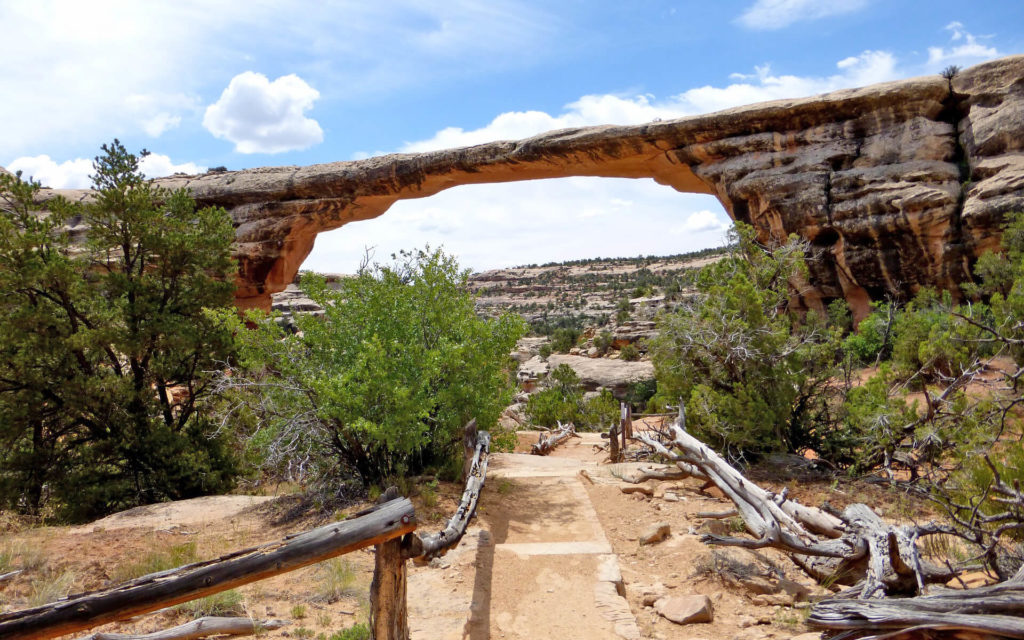
Natural Bridges National Monument, located in Utah, is an awe-inspiring destination that showcases the power of nature’s elements in carving out spectacular landforms. Established in 1908 and recognized as Utah’s first National Monument, it is home to three of the most impressive natural bridges in the world: Kachina, Owachomo, and Sipapu. Each named in honor of the ancestral Puebloans who once inhabited the region, these bridges have a rich history, with names reflecting the cultural heritage of the Hopi tribe, such as Sipapu, meaning “place of emergence”.
Visitors to Natural Bridges can experience the grandeur of these geologic formations from overlooks, or by venturing on hiking trails that allow an up-close perspective from beneath the bridges. The park’s landscape is defined by not only its namesake bridges but also by a high desert ecosystem, diverse wildlife, and remnants of ancient Puebloan structures. As the world’s first designated International Dark Sky Park, stargazers can delight in extraordinary night sky views unobstructed by light pollution. While services are limited in winter, the park is open year-round, offering a different kind of beauty and solitude in the colder months.
| Feature | Details |
|---|---|
| Location | Utah, United States |
| Established | April 16, 1908 |
| Notable Bridges | Kachina, Owachomo, Sipapu |
| Activities | Hiking, Photography, Stargazing, Cultural Site Visitation |
| Camping | Available on a first-come, first-served basis |
| Visitor Center | Information, exhibits, and books available |
| Accessibility | Facilities and programs accessible to all |
| Contact Information | 435-692-1234 x616, [email protected] |
14. Flaming Gorge National Recreation Area
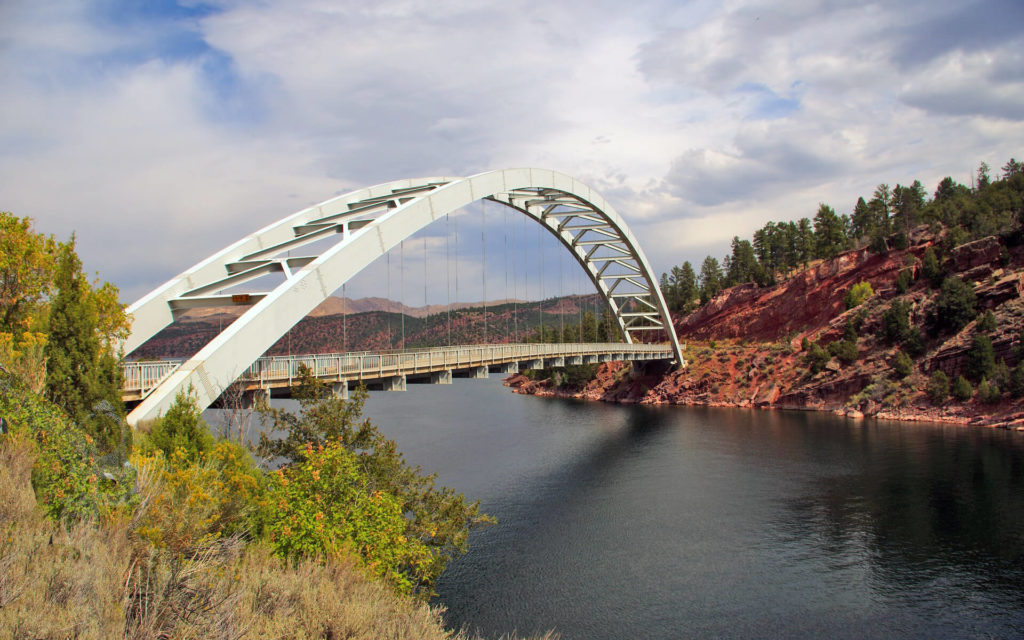
Flaming Gorge National Recreation Area is a stunning natural playground that serves as a visual feast with its deep canyons, vibrant rock formations, and the expansive Flaming Gorge Reservoir. Carved over millennia by the Green River, the area is now a hub for outdoor enthusiasts, offering a diverse range of activities across different seasons. In the warmer months, visitors can engage in hiking, boating, water skiing, camping, and fishing in the reservoir, famous for its trophy trout. The surrounding landscapes provide a habitat for a variety of wildlife and opportunities for nature photography, particularly at the high Uinta Wilderness which forms a picturesque backdrop.
The history of the region is as captivating as its geography, with traces of Paleo Indians, Fremont people, and Ute and Shoshoni Indians, as well as mountain men and explorers from the 19th century. Today, the area attracts visitors worldwide to enjoy world-class outdoor recreation. Managed by the USDA Forest Service, Ashley National Forest, and the USDI Bureau of Reclamation, Flaming Gorge National Recreation Area boasts over 600 camping and picnic units, two visitor centers, and over a hundred miles of trails. Wintertime brings snow sports into the spotlight, with cross-country skiing, snowmobiling, and snowshoeing among the activities that lure visitors during the cooler months.
| Feature | Details |
|---|---|
| Location | Utah and Wyoming, United States |
| Size | 207,363 acres, with a 91-mile long lake |
| Activities | Hiking, Camping, Boating, Fishing, Water Sports, Snow Sports |
| Wildlife | Diverse, including game fish, birds, and large mammals |
| Visitor Centers | Flaming Gorge Dam Visitor Center, Red Canyon Visitor Center, Green River Visitor Center |
| Reservations | Recommended for camping, available through Forest Service |
| Contact Information | Call 435-789-1181 for more information |
15. Monument Valley Navajo Tribal Park
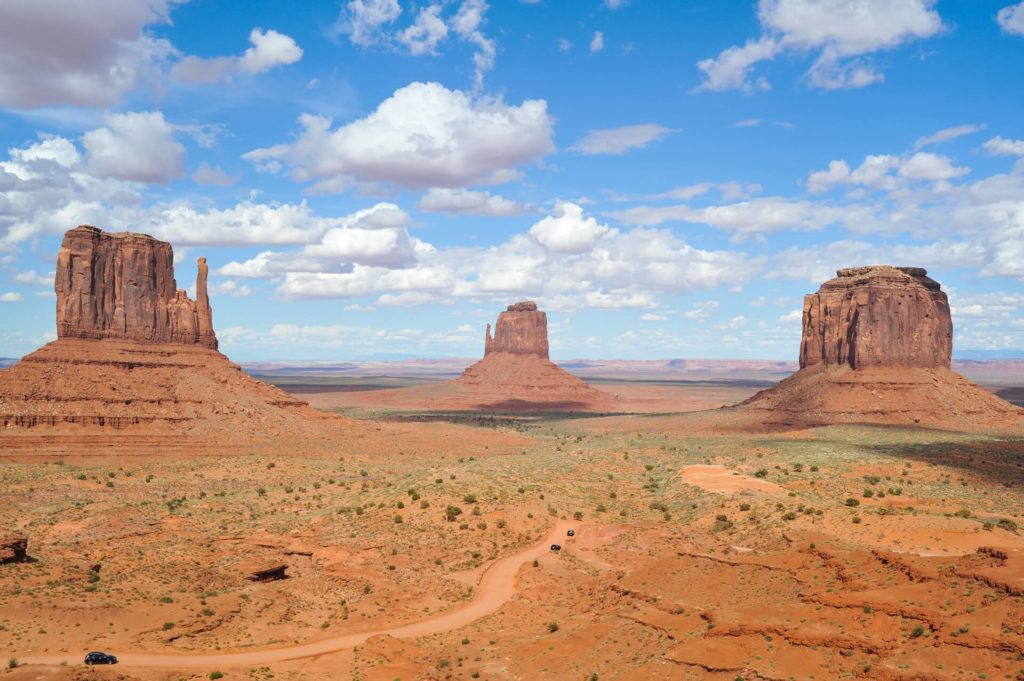
Monument Valley Navajo Tribal Park is a majestic landscape that showcases some of the most iconic and breathtaking formations in the United States. Its sandstone masterpieces soar between 400 to 1,000 feet above the valley floor, framed by captivating clouds that cast ever-changing shadows across the desert expanse. The park’s beauty is not just found in its towering rocks but also in the vast mesas, buttes, and windblown sands that create a tapestry of natural wonder. The park’s Navajo name, Tse’Bii’Ndzisgaii, translates to “the valley of the rocks,” reflecting the deep cultural significance and geological splendor of the area.
While exploring Monument Valley, visitors can embark on the 17-mile scenic loop drive on a self-guided tour, which offers stunning views of the park’s rock formations, including the famous Mitten Buttes and Merrick Butte. For an even closer look at the valley’s wonders, guided Jeep tours operated by Navajo guides are available, providing access to areas off the beaten path and sharing insights into Navajo history and culture. The Wildcat Trail is the only self-guided hiking path within the park, offering a 3.2-mile loop around the West Mitten Butte. Additionally, local artisans sell beautifully crafted jewelry and other handcrafted items along the loop road, allowing visitors to take home a piece of this memorable landscape.
| Feature | Details |
|---|---|
| Location | Navajo County, AZ & San Juan County, UT |
| Elevation | 5,564 feet above sea level |
| Scenic Drive | 17-mile loop, self-guided tours available |
| Hiking Trail | Wildcat Trail, 3.2-mile loop (Sign in/out at Visitor Center) |
| Guided Tours | Jeep tours with Navajo guides |
| Entry Fee | $8 per person, per day (Subject to change) |
| Hours of Operation | 8:00 am to 5:00 pm, Last Entry at 2:30 pm (Winter Hours) |
| Motorcycles | Not permitted on loop drive |
| Contact Information | (928) 871-6647, [email protected] |
FAQs
How many state parks are in Utah?
There are 44 state parks in Utah, ranging from Bear Lake's deep blue waters to Coral Pink Sand Dunes' hot, orange, and pink sands.










